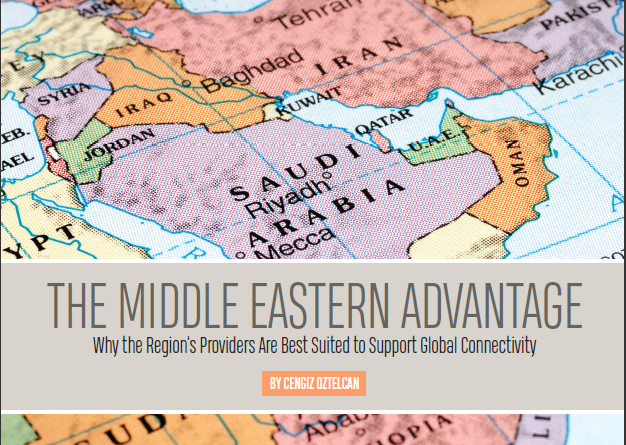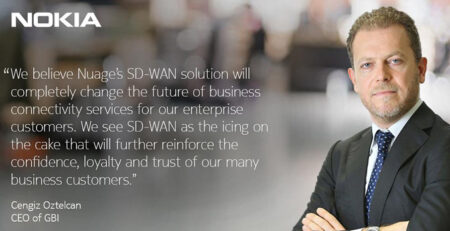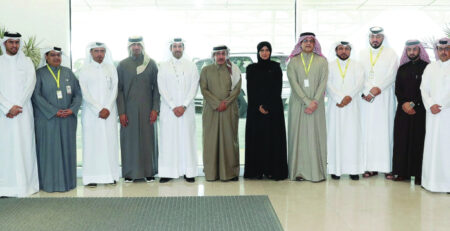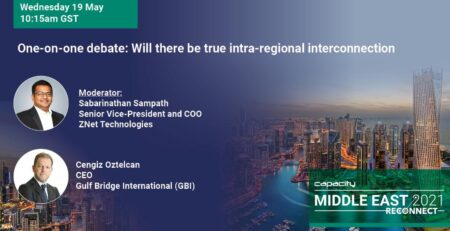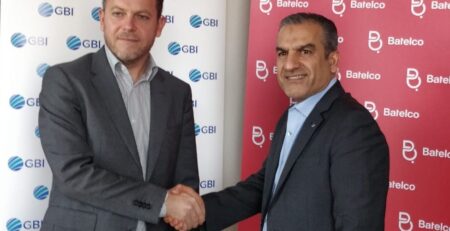The Middle Eastern Advantage
Cengiz Oztelcan
July 22, 2021
Uniquely positioned, Middle Eastern connectivity providers are key to global digital transformation and operations, connecting East and West and possessing the geopolitical expertise to operate across all regions
As organisations in all corners of the globe seek to pursue digital transformation, the importance of super-fast, super-reliable connectivity networks is at an all-time high. Businesses must be able to connect to different global locations both directly and seamlessly, ensuring that latency issues do not have a costly impact on customer and employee digital experiences.
Now that cloud technologies are maturing and the rollout of 5G is gathering pace, some may have lost sight of the vital role played by submarine and terrestrial cable networks in high-quality connectivity. The reality is that 98% of all international internet traffic travels through them, and they have become the essential enabler for business-critical services.
There are roughly 400 subsea cables functioning worldwide, offering varying levels of connectivity quality and capacity. Pick a point A and a point B on a global map and there is likely one or more subsea cables connecting them. These subsea cables serve as the information super-highways of the world. However, for global organisations looking for connectivity, it would be naive to believe that all routes are created equal.
For a moment, let’s think about global shipping routes which provide an apt comparison for the importance of connectivity cable networks. The Suez Canal links the Red and Mediterranean seas, making it the shortest maritime route from Asia to Europe. In relatively recent history, the route has revolutionised the speed and reliability of shipping and has spurred global innovation. It completely removes the need to sail around the entirety of Africa, a route that will still get you from ‘A’ to ‘B’ but just in a much longer timeframe.
We don’t have to go back too far to see what happens when one of these routes is taken out of action, even for a few days. In March 2021, the Suez Canal was blocked for five days after a container ship – the Ever Given – became stuck. The knock-on effects saw price rises as goods were unable to pass through causing delays and shortages to global supply chains. In order to keep moving, some ships took the Cape of Good Hope route around Africa (the route required before the Suez Canal was opened in 1869) which can add up to two weeks journey time.
Switching back to connectivity, longer route lengths have a direct impact on latency which in turn affects an organisations’ performance. For those in Asia, the Middle East, or Europe looking to realise their digital transformation goals, latency is a considerable challenge and subsea cable routes that take data past South Africa should be an immediate red flag to potential performance.
That’s why subsea cable providers based in the Middle East are uniquely equipped and situated to deliver intraregional connectivity systems. Linking the three regions via numerous points of presence and cable landing stations, they provide the most direct route which contributes to lower latency and enhanced overall performance.
The backbone of modern communication
Once driven by the need for access to low-cost connectivity, investment in submarine cables is now being driven by a demand for high volume, high-quality connectivity. Emerging technologies and services demand low latency as a minimum requirement, with society as a whole becoming increasingly dependent on digital devices, the internet of things, and connected technology.
Enterprises are also constantly calling for increased capacity and reduced latency in a bid to provide customers with innovative, differentiated digital services and experiences. A prime example is the growing deployment of augmented and virtual reality technologies (AR/VR), for the benefit of customers and staff alike in different sectors. The performances of these cutting-edge technologies hinge on connectivity quality, particularly in mission critical use cases.
Extensive subsea and terrestrial cable networks are vital to ensuring the availability of this kind of connectivity, particularly when reliable connectivity is required both ways on a single route. This is made apparent in the case of SD-WAN technology, software-defined networking within a wide area network. SD-WAN offers a range of benefits to organisations, including centralised manageability and reduced costs, but these can only be effectively unlocked through robust international connectivity.
The Middle Eastern advantage
To access the robust, high-quality connectivity necessary for the tech opportunities we have discussed above, carriers and enterprises cannot afford to compromise. In geographical terms, the Middle East is perfectly situated to serve as a bridge between the Eastern and Western worlds, so providers located in the region represent the ideal connectivity partner for global organisations looking to enhance their capabilities at scale.
As the Suez Canal quickly became the most important artery and waterway for world trade in 1869, subsea and overland cable networks in the Middle East are today’s equivalent. One of the forces driving the global importance of Middle Eastern cable networks is China’s growing Belt & Road Initiative (BRI), a transcontinental policy of infrastructure development and economic integration. Above all, it seeks to connect Asia with Europe and Africa via maritime and land networks, building on the concept of the ancient Silk Road.
Projects within the BRI potentially offer the opportunity for the expansion of trade and investment. In terms of trade specifically, some theorise that full implementation of the BRI could increase global trade by up to 6.2 per cent, potentially increasing global real income by as much as 2.9 per cent. While debate and discussion are ongoing around the progress and potential of the BRI, it is important that carriers and enterprises are appropriately equipped.
To maximise the potential opportunities presented by this strengthening connection between Asia and Europe, the first thing organisations must consider is connectivity.
In addition to emerging Eurasian business opportunities, it is expected that in the Middle East and North Africa (MENA) regions alone there will be up to 93 million new mobile subscribers using the internet by 2025. This statistic represents a huge CAGR increase of 5.1% between 2019 and 2025, with North Africa set to account for a third of these new users.
It is clear that there is immense potential for carriers and enterprises to tap into a range of global business opportunities if they prioritise quality connectivity, but there is another important decision-making factor. It is essential that organisations choose to work with a single cable network provider that is highly experienced in operating across these three key global regions, in terms of cultural nuances as well as regulatory and geopolitical factors. Connectivity providers must also provide a solid foundation to support their customers’ digital journeys, a foundation that can be built on and utilised to deliver an optimised end-user experience.
Experience is critical to success
Middle Eastern providers with an extensive understanding of cultural and regional business nuances have unparalleled knowledge of all surrounding key regions. This geographical positioning and expertise equip them far better than dislocated providers based in Europe or Asia. This extensive understanding of cultural and regional business nuances ensures that organisation can conduct effective global business.
To provide insight into the complexities of worldwide cultural nuances there are some key things to consider. For example, in the Middle East it is important to prioritise building trust and to avoid political discourse, in Asia business etiquette – such as treating business cards with the utmost respect – should be adhered to, and in Europe building relationships is key. This snapshot sample is indicative of the importance of working with a provider who can not only understand your organisation’s culture but one that can help you successfully navigate the nuances within intraregional and the wider landscape.
While the business and cultural nuances across different regions pose a complex obstacle, so do their varying regulatory landscapes. Having a deep understanding of different regulatory processes is a distinct competitive advantage for providers in the Middle East. As they operate with landing points based in multiple countries and continents, they enter the remit of various regulatory bodies. This means they possess the know-how to keep associated organisations maintaining compliance as operations sprawl between nations, ensuring the smooth delivery of services.
Significant expertise is also required of providers to navigate the world’s complex geopolitical landscape, particularly when it comes to engaging with countries across the Gulf. At this present moment in time, it is more important than ever to work with a provider that is experienced in the geopolitics of intra- and interregional cable networks, with issues on the subject hitting national headlines.
Reliance on subsea cables for connectivity has brought larger OTT players into geopolitical discussions. Recently, Facebook dropped out of a Hong Kong-Americas submarine cable project due to mounting pressure from the US. With submarine cables set to be essential for moving growing quantities of data, it is essential that organisations work with an expert provider that can understand and traverse geopolitical volatility.
The enablers of future business growth
With worldwide data set to reach a towering 59 zettabytes in 2021, international internet bandwidth and traffic are simultaneously growing at a CAGR of 30%. Enterprises and societies more widely are becoming increasingly dependent on connectivity, while the need to move larger datasets become paramount. While satellites have been suggested as a means of managing this need, they simply cannot provide the business-critical speed and capacity required for digital transformation at a global scale.
As carriers and enterprises experience this growing call for reliable, low latency connectivity, providers in the Middle East are uniquely positioned to provide an effective solution for the future. While offering unique and diverse connectivity opportunities, they also provide the crucial regulatory and geopolitical expertise that will be crucial to the future of global business and transformation.
This combined plethora of advantages is what makes Middle Eastern providers the foundation for future global business and innovation. In 1870, the Suez Canal saw 486 transits in its first year of operation, in 2019 there were nearly 19,000. With data volumes doubling every eighteen months, Middle Eastern networks stand to be the Suez Canal of the modern connectivity space that will link the East and West.

